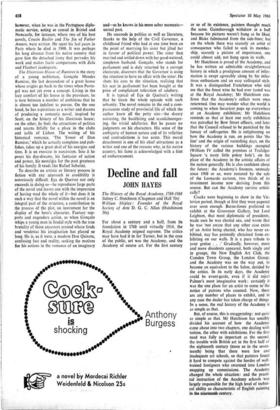Decline and fall
JOHN HAYES
The History of the Royal Academy, 1768-1968 Sidney C. Hutchison (Chapman and Hall 70s) William Shipley : Founder of the Royal Society of Arts D. G. C. Allan (Hutchinson 50s) For about a century and a half, from its foundation in 1768 until virtually 1914, the Royal Academy reigned supreme. The critics may have had it in for Turner, but in the eyes of the public, art was the Academy, and the Academy of course art. For the first century or so of its existence, painters, thought much the same. Gainsborough withdrew in a huff because his pictures weren't hung as he liked, and Blake fulminated from the side-lines; but on the whole there was scarcely an artist of consequence who failed to seek its member- ship, scarcely a picture of importance, one could almost add, not hung upon its walls.
Mr Hutchison is proud of the Academy, and he has written an admirable straightforward history in which a prodigious amount of infor- mation is swept agreeably along by his infec- tious enthusiasm and an easy colloquial style. It was a distinguished Frenchman who told me that the finest wine he had ever tasted was at the Royal Academy; Mr Hutchison con- firms that the Academy's cellars were once renowned. One may wonder what the world is coming to when Securicor pops up everywhere at an Academy exhibition; Mr Hutchison reminds us that at least one early exhibition was patrolled by Bow Street officers, and later that the Council refused to be panicked by the lunacy of suffragettes. He is enlightening on how the Academy is run, on points like 'the line' and the origin of varnishing days, on the history of the various buildings occupied (William IV called the premises at Trafalgar Square. 'a nasty little pokey hole'), on the place of the Academy in the artistic affairs of the nation generally. He is also confident about the future: the Academy's finances, unsteady since 1908 or so, were restored by the sale of the Leonardo cartoon, two thirds of its investment income now deriving from this source. But can the Academy survive artisti- cally?
Cracks were beginning to show in the Vic- torian period, though at first they were papered over soon enough. Burne-Jones preferred to exhibit at the Grosvenor Gallery, but Lord Leighton, that most diplomatic of presidents, made sure he was elected ARA, and wrote that he was 'not aware that any other case exists of an Artist being elected, who has never ex- hibited, nay has pointedly abstained from ex- hibiting on our walls. It is is pure tribute to your genius . . Gradually, however, more and more dissidents appeared, both singly and in groups, the New English Art Club, the Camden Town Group, the London Group; and the Academy was on the way out, to become an equivalent to the Salon, derided by the critics. In its early days, the Academy could be avant-garde, even if it did reject Palmer's most imaginative work: certainly it was the one place for an artist to come to.the notice of patrons who counted. Now, there are any number of places to exhibit, and in any case the dealer has taken charge of things. In a sense, the real history of the Academy is as simple as that.
But, of course, this is exaggerating: not quite as simple as that. Mr Hutchison has sensibly divided his account of. how the Academy came about into two chapters, one dealing with tuition, the other with exhibitions. For the first need was fully as important as the second, the trouble with British art in the first half of the eighteenth century (more so in the seven- teenth) being that there were few and inadequate art schools, so that painters found it hard to compete against the hordes of well- trained foreigners who swarmed into London snapping up commissions. The Academy changed the whole situation: and the practi- cal instruction of the Academy schools was largely responsible for the high level of techni- cal ability so characteristic of English painting ninatueallt -century.
-Closely allied to teaching was some proper prowision for studying the art of the past. It was actually the British Institution which started a series of winter -exhibitions of Old Masters; but when these came to an end in 1267, the Academy took on the job. Both the schools and the loan exhibitions (the greatest being 'Italian Art' in 1930, when Mussolini had half his country's masterpieces shipped to Bur- lington House) have kept the Academy's reputation bright this century.
William Shipley, the founder of the Royal Society of Arts, was a professional painter of no special distinction, celebrated in his day for the private drawing school he opened in 1754; but, similar though his aims were, he seems to have had no connections with the founders of the Academy. Inoffensive and somewhat priggish in character—rather grumpy, too, to judge by the portraits—Shipley was an inveterate inventor and do-gooder who, given half a chance, would have founded much else besides the Society of Arts. Little was known formerly about his life, and we are indebted to Mr Allan for producing a wealth of new material. Mr. Allan is sometimes carried away by the processes of research, better relegated to footnotes; and it is a pity that having run to earth an example of Shipley's painting, he fails to reproduce it. Let no one imagine that this book is bedside reading, but here in minute detail is almost everything one wants to know about a man who deserves more than a modest niche in the history of the age that was running mad after innovations.







































 Previous page
Previous page